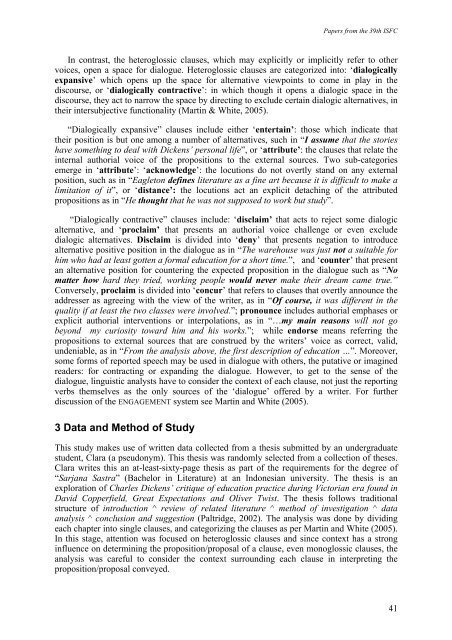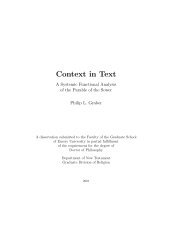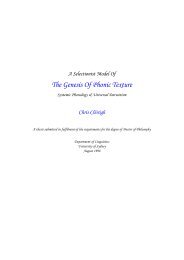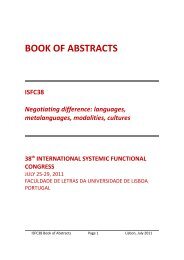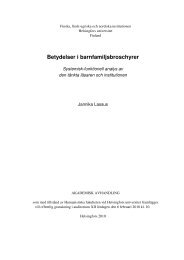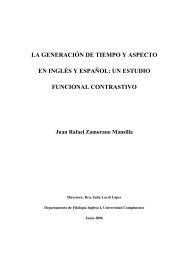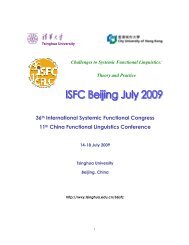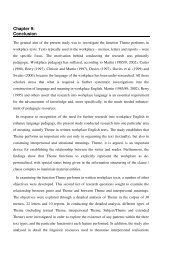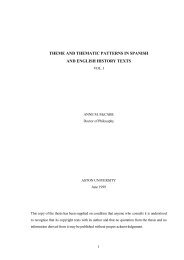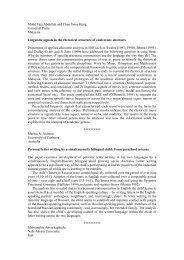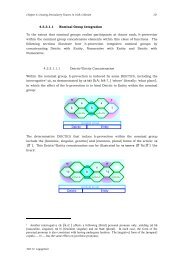the ISFC39 Proceedings - International Systemic-Functional ...
the ISFC39 Proceedings - International Systemic-Functional ...
the ISFC39 Proceedings - International Systemic-Functional ...
You also want an ePaper? Increase the reach of your titles
YUMPU automatically turns print PDFs into web optimized ePapers that Google loves.
Papers from <strong>the</strong> 39th ISFCIn contrast, <strong>the</strong> heteroglossic clauses, which may explicitly or implicitly refer to o<strong>the</strong>rvoices, open a space for dialogue. Heteroglossic clauses are categorized into: ‘dialogicallyexpansive’ which opens up <strong>the</strong> space for alternative viewpoints to come in play in <strong>the</strong>discourse, or ‘dialogically contractive’: in which though it opens a dialogic space in <strong>the</strong>discourse, <strong>the</strong>y act to narrow <strong>the</strong> space by directing to exclude certain dialogic alternatives, in<strong>the</strong>ir intersubjective functionality (Martin & White, 2005).“Dialogically expansive” clauses include ei<strong>the</strong>r ‘entertain’: those which indicate that<strong>the</strong>ir position is but one among a number of alternatives, such in “I assume that <strong>the</strong> storieshave something to deal with Dickens’ personal life”, or ‘attribute’: <strong>the</strong> clauses that relate <strong>the</strong>internal authorial voice of <strong>the</strong> propositions to <strong>the</strong> external sources. Two sub-categoriesemerge in ‘attribute’: ‘acknowledge’: <strong>the</strong> locutions do not overtly stand on any externalposition, such as in “Eagleton defines literature as a fine art because it is difficult to make alimitation of it”, or ‘distance’: <strong>the</strong> locutions act an explicit detaching of <strong>the</strong> attributedpropositions as in “He thought that he was not supposed to work but study”.“Dialogically contractive” clauses include: ‘disclaim’ that acts to reject some dialogicalternative, and ‘proclaim’ that presents an authorial voice challenge or even excludedialogic alternatives. Disclaim is divided into ‘deny’ that presents negation to introducealternative positive position in <strong>the</strong> dialogue as in “The warehouse was just not a suitable forhim who had at least gotten a formal education for a short time.”, and ‘counter’ that presentan alternative position for countering <strong>the</strong> expected proposition in <strong>the</strong> dialogue such as “Nomatter how hard <strong>the</strong>y tried, working people would never make <strong>the</strong>ir dream came true.”Conversely, proclaim is divided into ‘concur’ that refers to clauses that overtly announce <strong>the</strong>addresser as agreeing with <strong>the</strong> view of <strong>the</strong> writer, as in “Of course, it was different in <strong>the</strong>quality if at least <strong>the</strong> two classes were involved.”; pronounce includes authorial emphases orexplicit authorial interventions or interpolations, as in “…my main reasons will not gobeyond my curiosity toward him and his works.”; while endorse means referring <strong>the</strong>propositions to external sources that are construed by <strong>the</strong> writers’ voice as correct, valid,undeniable, as in “From <strong>the</strong> analysis above, <strong>the</strong> first description of education …”. Moreover,some forms of reported speech may be used in dialogue with o<strong>the</strong>rs, <strong>the</strong> putative or imaginedreaders: for contracting or expanding <strong>the</strong> dialogue. However, to get to <strong>the</strong> sense of <strong>the</strong>dialogue, linguistic analysts have to consider <strong>the</strong> context of each clause, not just <strong>the</strong> reportingverbs <strong>the</strong>mselves as <strong>the</strong> only sources of <strong>the</strong> ‘dialogue’ offered by a writer. For fur<strong>the</strong>rdiscussion of <strong>the</strong> ENGAGEMENT system see Martin and White (2005).3 Data and Method of StudyThis study makes use of written data collected from a <strong>the</strong>sis submitted by an undergraduatestudent, Clara (a pseudonym). This <strong>the</strong>sis was randomly selected from a collection of <strong>the</strong>ses.Clara writes this an at-least-sixty-page <strong>the</strong>sis as part of <strong>the</strong> requirements for <strong>the</strong> degree of“Sarjana Sastra” (Bachelor in Literature) at an Indonesian university. The <strong>the</strong>sis is anexploration of Charles Dickens’ critique of education practice during Victorian era found inDavid Copperfield, Great Expectations and Oliver Twist. The <strong>the</strong>sis follows traditionalstructure of introduction ^ review of related literature ^ method of investigation ^ dataanalysis ^ conclusion and suggestion (Paltridge, 2002). The analysis was done by dividingeach chapter into single clauses, and categorizing <strong>the</strong> clauses as per Martin and White (2005).In this stage, attention was focused on heteroglossic clauses and since context has a stronginfluence on determining <strong>the</strong> proposition/proposal of a clause, even monoglossic clauses, <strong>the</strong>analysis was careful to consider <strong>the</strong> context surrounding each clause in interpreting <strong>the</strong>proposition/proposal conveyed.41


